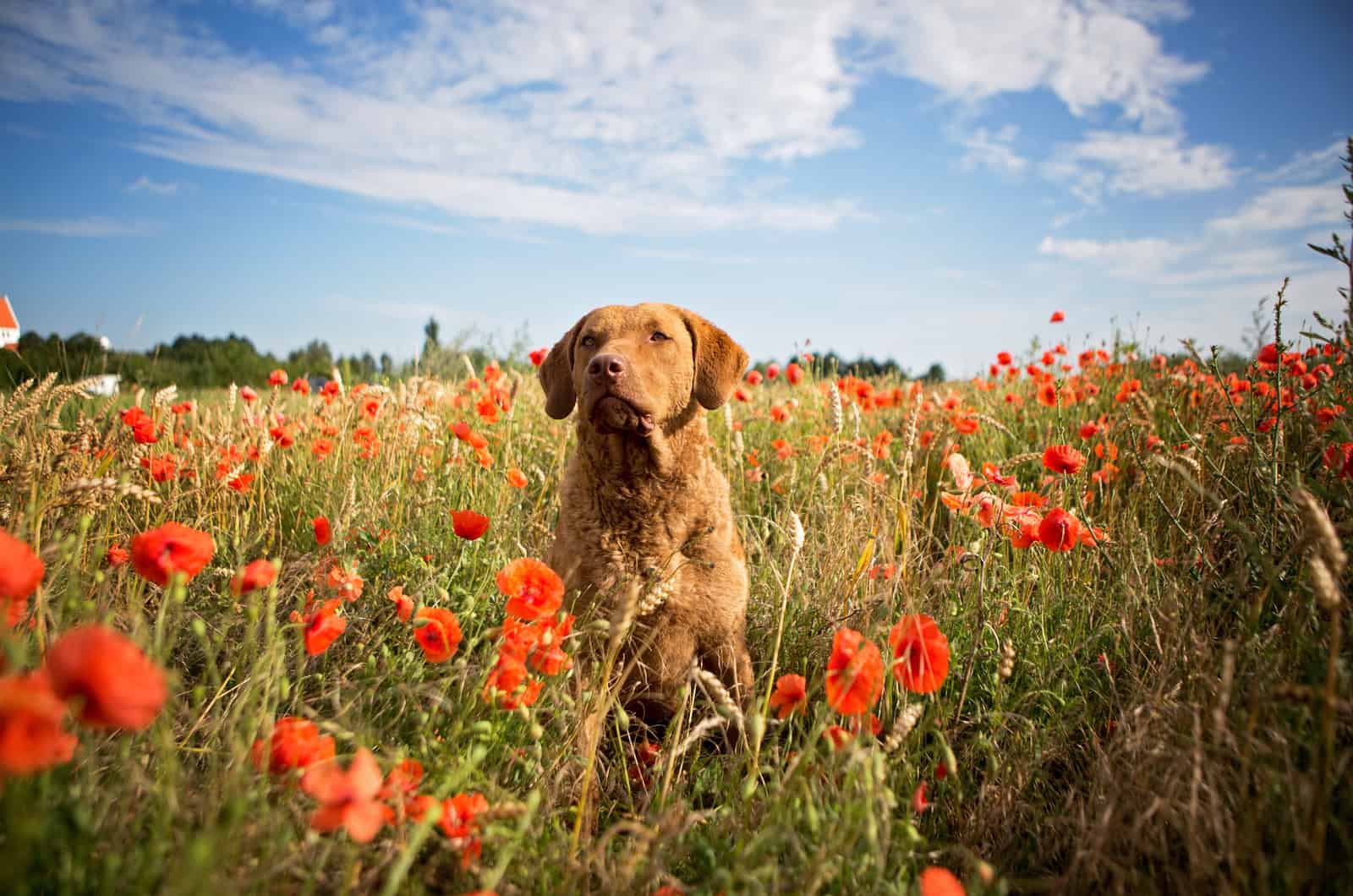The Chesapeake Bay Retriever dog breed is also known as the gundog of the Mid-Atlantic – it’s believed to have originated in the 19th century in Chesapeake Bay, which is located off the coast of Maryland.
As the story goes, the heritage of the Chesapeake Water Dogs began after two Newfoundland puppies were rescued from a shipwreck off the coast of Maryland – those dogs were later cross-bred with Irish Water Spaniels, Irish Setters, and other waterfowl hunting dogs, which over time, resulted in the Chesapeake Bay Retriever breed.
Since other breeds refused to obey and go into the freezing waters, the sportsmen at the time needed a resilient dog that would be able and willing to retrieve their game birds – the Chesapeake Bay Retriever was the only dog brave enough, and the only one adequately equipped for the job, due to their dense double-coats.
Although this beautiful dog breed was bred to serve as a versatile hunting dog, today, Chessies are mainly kept as companion dogs.
Their versatility, however, is what makes them a popular choice for individuals who require a diligent, obedient, intelligent, and sturdy hunting companion – which is why the American Kennel Club classifies them in the sporting, hunting, and retrieving groups.
Whatever the reason behind your interest in Chesapeake Bay Retrievers, you’ve probably come to this article to find out what colors these Chessies come in.
So, without further ado, let’s dive in and explain which Chesapeake Bay Retriever colors there are, and what makes these beautiful dogs unique, besides their appearance.
Chesapeake Bay Retriever Colors: An Overview
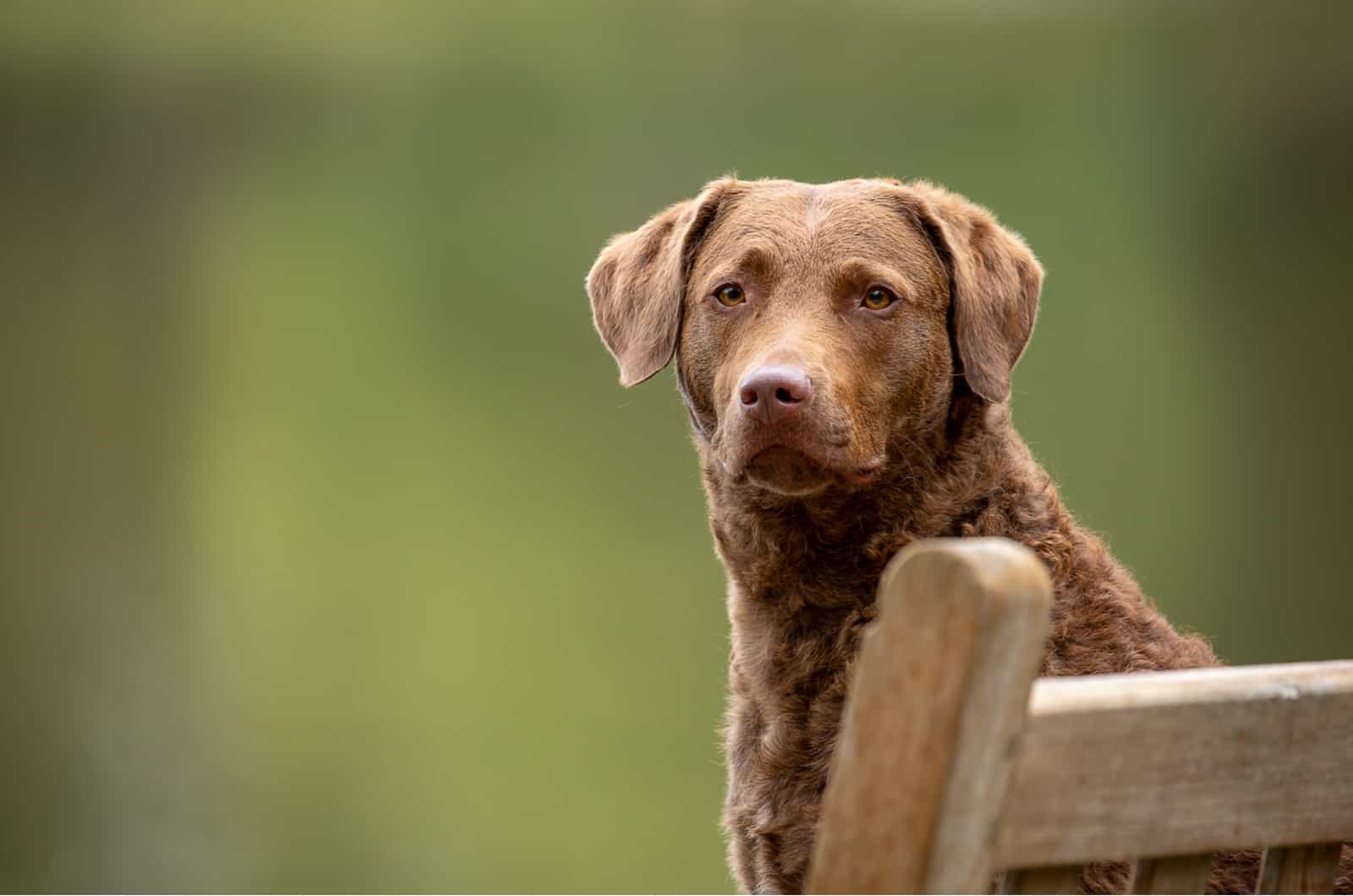
We’ll go over all the different Chesapeake Bay Retriever colors in more detail in a bit – but first, we’ll give you a quick overview.
According to the American Chesapeake Club’s and the AKC’s Chesapeake Bay Retriever breed standard, the three basic colors that are officially recognized are:
• Brown – ranging from Light brown, through milky chocolate, to a deep bittersweet chocholate color.
• Sedge (red) – ranging from a reddish yellow, through bright red, to a deeper chestnut shade.
• Deadgrass (yellow) – ranging from a light yellow shade to a dull straw color.
In order to conform to the breed standard as closely as possible, all Chesapeake Bay Retrievers must be self-colored – meaning that they must be uniformly colored, without lighter or darker shades of the same color anywhere on their body.
Of course, there are Chessies that have varying degrees of different markings, like tan points, stripes of lighter and darker shadings, saddle markings, or masking on top of their head – and while these markings may not be favored, they do not warrant disqualification.
Since color counts for only 4 out of 100 points in conformation shows, Chesapeake Bay Retrievers with these kinds of patterns shouldn’t be arbitrarily disqualified.
Chessie colors that are not officially recognized by the AKC and that warrant disqualification are any black or white spots on the dog’s body – with the exception of a small area on the toes, rear pad, or the chest and belly being acceptable.
Now, let’s take a more in-depth approach to the different Chesapeake Bay Retriever colors.
1. Brown Chesapeake Bay Retrievers
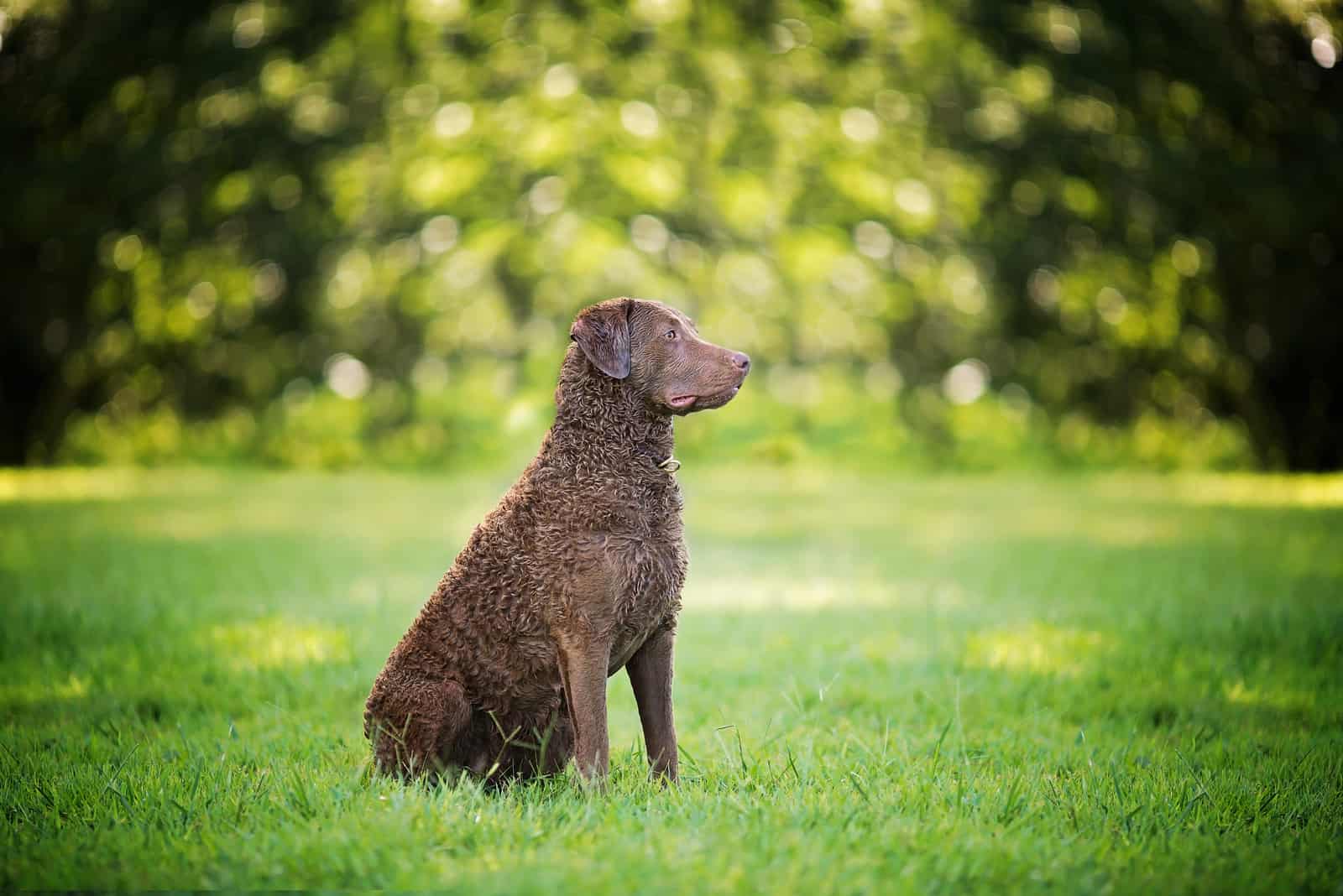
Since they were bred to be gundogs that were supposed to match their hunting environment in order to quickly pounce on and retrieve game birds – a Chesapeake Bay Retriever’s coat color is what determines how successful they are at hunting.
Brown is the first of the three basic colors that Chesapeake Bay Retrievers come in.
Chesapeake Bay Retriever puppies that are born with a brown coat can exhibit various shades of brown, ranging from light caramel, through a cocoa brown, to a dark brown.
Dark brown Chessies blend in well with the muddy banks of the bay or river they’re hunting in, while lighter shades of brown Chesapeakes perfectly camouflage themselves in the dead weeds and grasses that grow along the banks.
2. Sedge Chesapeake Bay Retrievers
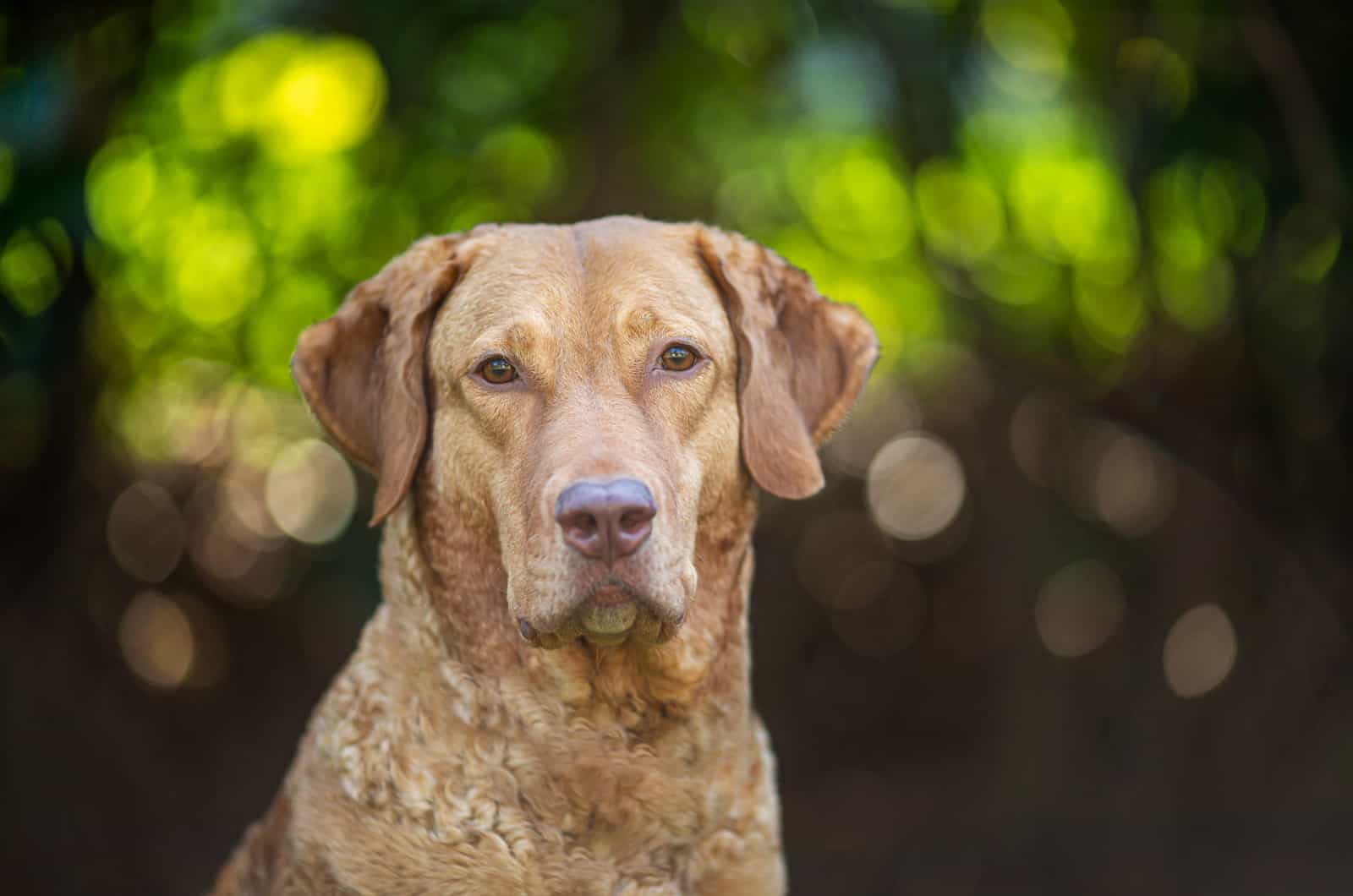
The second officially recognized Chesapeake Bay Retriever color is Sedge – which is essentially a red coat color.
Red-colored Chesapeake Bay Retrievers are dubbed “Sedge-colored” due to their ability to blend in with the grasslike plant that grows on wet ground, which is called Sedge.
All along the Chesapeake Bay, sedge turns a bright red color in the fall – so, a Sedge-colored Chesapeake Bay Retriever effortlessly blends in with its surroundings.
Sedge colors range from a light Irish Setter red, through strawberry-red, to a deep mahogany color.
Of course, Sedge dogs can also have darker and lighter patterns strewn across their body, such as bridling, saddling, and masking – although self-colored or solid-colored Chesapeakes more closely resemble the ideal dog according to the breed standard, varied markings and patterns don’t mean that the dog is any less acceptable.
3. Deadgrass Chesapeake Bay Retrievers

Photo from: @thekirbster_
The third basic color that’s officially recognized by both official Breed Clubs is called Deadgrass, which is essentially a term used to describe Chesapeake Bay Retrievers that are yellow-colored – ranging from a light yellow, through faded tan, to a dull straw yellow.
Deadgrass-colored Chesapeake Bay Retrievers easily camouflage themselves amongst the dead grasses and wheat stalks that turn a dirty-yellow color in the fall.
It’s interesting to note that some of the lighter Deadgrass shades observed in Chesapeake Bay Retrievers are so light that they appear almost white – while darker shades of Deadgrass colors are sometimes diluted, and can appear almost gray-colored.
These types of Deadgrass Chessies are known as ash-colored and are much less common to see than other colors.
The main difference between the Deadgrass and Sedge coat colors is that the Deadgrass shades don’t contain any red pigmentation, while Sedge is primarily red in color.
Of course, the wavy coat of the Chesapeake Bay Retriever also plays a factor in color perception – sometimes a dog can appear lighter or darker depending on various external factors.
A Deadgrass Chessie can appear to be a light brown when it’s just gotten out of the water, and the wavy pattern around its neck, chest, and along its back can add to this illusion.
The Chesapeake Bay Retriever’s Eye Color
One thing that doesn’t depend on a Chessie’s coat color is its eye color – most Chesapeake Bay Retriever puppies are usually born with either amber-colored eyes or yellow-colored eyes and this is considered to be the breed standard.
As far as judges at conformation shows are concerned, the eye color of the Chesapeake isn’t taken into consideration and carries no points, no matter whether the coat color and eye color of the dog match or not.
Although Chesapeake Bay Retriever breeders might have a preference of coat and eye colors matching, the breed standard does not require it.
Some Chesapeake Bay Retriever puppies are born with blue eyes, but this is a rare sight to see and usually means that the dog is not entirely purebred (blue eyes in a puppy could indicate that it’s mixed with a breed such as the Siberian Husky), therefore, this is the only eye color that might disqualify a Chessie in a conformation show.
This is not to be confused with dogs whose eye color changes to blue from their original colors – such abrupt and extreme changes in eye color might indicate that a dog has developed an eye disease such as Glaucoma.
The Chesapeake Bay Retriever’s Coat
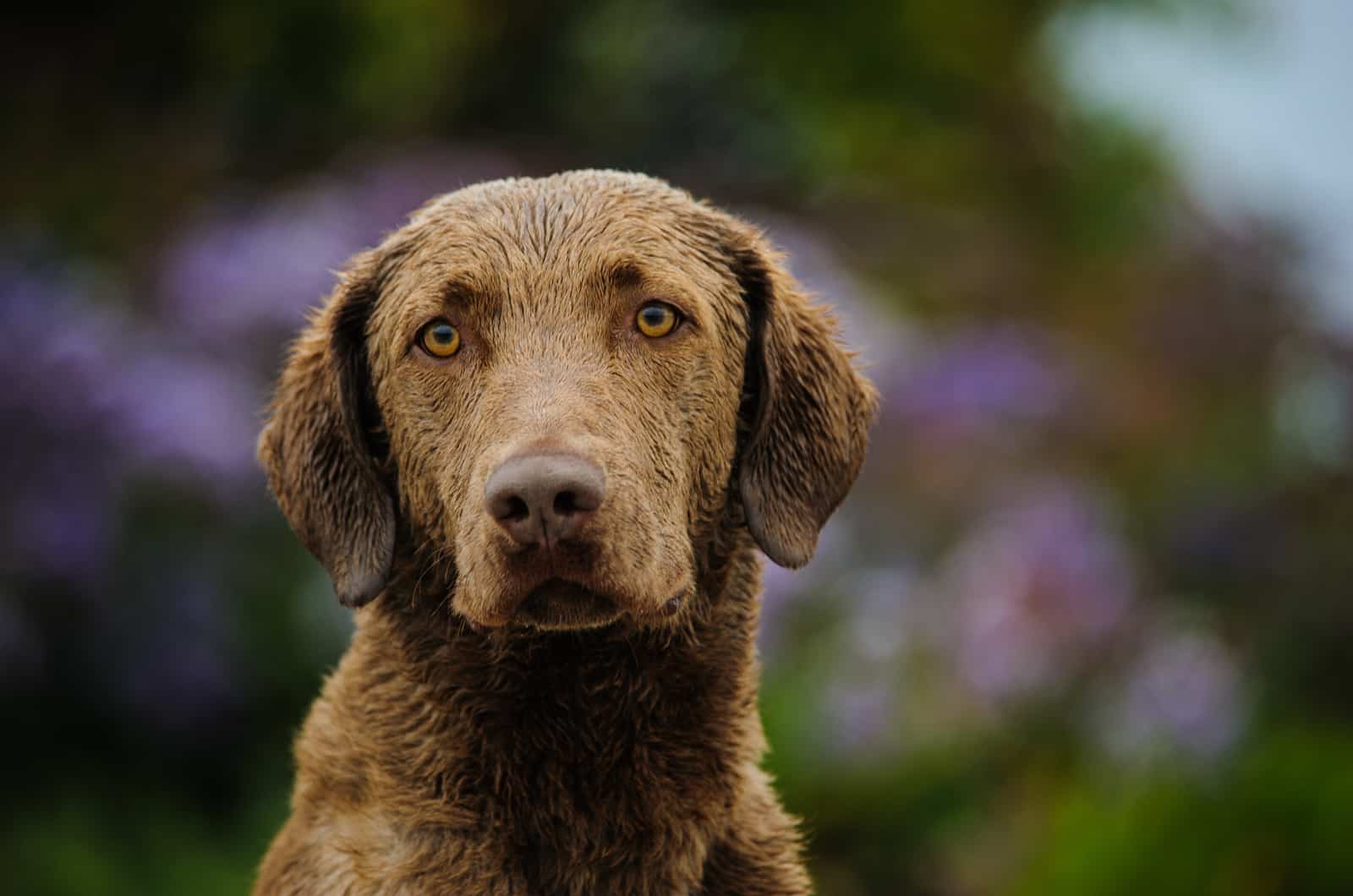
What makes purebred Chesapeake Bay Retrievers unique is their medium-length, waterproof double-coat, which allows them to survive long periods of time drenched in icy waters.
The Chessie’s coat begins at the skin as a wooly, thick undercoat – so thick in fact, that it can be difficult to see their skin when you part it.
This dense undercoat keeps water from reaching the skin and helps them maintain a normal body temperature while swimming in freezing climates.
On top of their dense undercoat is another layer that is much less dense, but is still thick enough – this outer coat is wiry and short, not much more than an inch and a half long.
The Chessie’s distinct double coat holds natural oil that is secreted by the skin, which effectively makes the Chesapeake Bay Retriever’s coat waterproof – when a Chessie comes out of the water and shakes off excess water, they are barely even damp, but their coat will have an oily feel to it.
According to the breed standard, one thing that is also characteristic of Chesapeake Bay Retrievers is their wavy coat pattern, which must be present on their loin, back, shoulders, and neck only – the hair on the legs and face must be straight and short.
There can be some feathering on the rear hindquarters and tail, but there should be no wave present on the sides of the dog – a wavy coat that covers the entire body of a Chessie warrants disqualification.
Chesapeake Bay Retriever Breed Characteristics
Since the Chesapeake Bay Retriever is a working dog, gundog, sporting dog, and most importantly, a retriever – its hunting and retrieving instincts run strong, and it is quite similar in temperament and appearance to its cousin, the Labrador Retriever.
Both breeds have waterproof double coats and have a similar purpose – but the Chesapeake Bay Retriever has a wavy coat, while the Labrador Retriever’s coat is straight and smooth.
As far as temperament goes, Chesapeake Bay Retrievers are more resilient, slightly more energetic, and equally as intelligent as their Labrador cousins.
The main physical difference to note is that Chesapeakes are slightly bigger than Labradors, and they have deeper chests.
These dogs are known for their high prey drive, working ability, endurance, resilience, and courage – they function best and are in their element when they have a job to do.
Apart from being useful and intelligent gundogs, Chesapeake Bay Retrievers are also friendly companion dogs that have a soft spot for their owners – but these dogs are not recommended for first-time owners due to their high energy levels and prey drive.
Chesapeake Bay Retrievers are ideal working companions and they’re best suited to experienced canine enthusiasts who live an active lifestyle and need an equally active dog.
Differences Between Male And Female Chesapeake Bay Retrievers
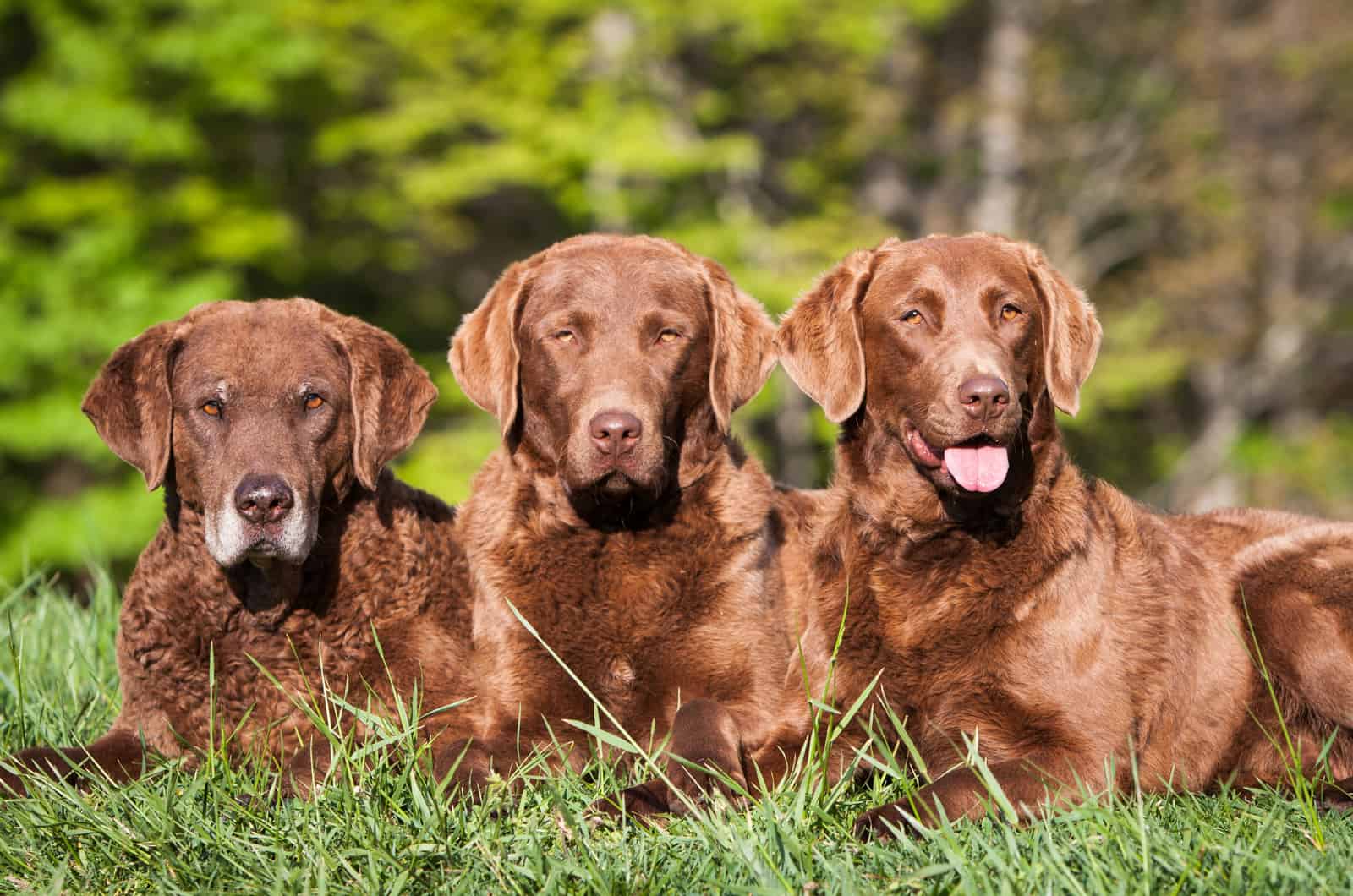
Firstly, we want to clear up the confusion that’s present for a lot of people who think that Chesapeake Bay Retrievers are rare dogs.
The truth is, although the Chesapeake Bay Retriever isn’t as world-famous or as popular as its Labrador Retriever cousin, they’re not as rare as you might think.
There are plenty of reputable and reliable Chesapeake Bay Retriever breeders all across the US, but the ones you should go to if you’re looking for a puppy, are breeders from Maryland, the place where these dogs originated.
That said, since the Chesapeake Bay retriever was originally bred to be a working dog, both the males and females are bred for trainability, strength, endurance, and a strong work ethic.
However, there are some differences between male and female Chessies – mainly physical ones, and a couple of temperamental ones.
Picking the right gender is crucial if you’re looking for a life-long companion, so you should make sure that you learn about their differences and weigh up your options before committing to a puppy.
That said, it’s also important to note that neither gender is necessarily better than the other – it’s more a matter of your personal preference and needs.
So, let’s check out the differences between the two genders.
Male Chesapeake Bay Retrievers
One obvious physical difference between the two genders is their size.
Male Chesapeake Bay Retrievers stand between 23 and 26 inches at the withers and weigh anywhere between 65 and 80 pounds on average.
Females weigh between 55 and 70 pounds and stand between 21 and 24 inches at the withers.
Male dogs, in general, are more playful and have higher energy levels than their female counterparts – this is also the case with Chesapeake Bay Retriever puppies.
Although female dogs are also playful and energetic in puppyhood, they quickly grow out of their puppyish behavior, while male dogs often retain their puppyish behavior, even in adulthood.
Male Chessies are less cooperative and tend to be less perceptive – they’re also worse at focusing on a set task for extended periods of time, so training a male might be a bit more difficult than training a female.
However, male Chesapeake Bay Retrievers usually calm down after being neutered – once you fix a male, the differences between the two genders are less apparent.
Another thing to note is that male dogs are often more aggressive toward small animals and strangers –statistics show that the total percentage of dog bites consists of a greater number of male dogs as the perpetrators.
If you need some tips and tricks on how to curb your dog’s aggression – check out our article on How To Socialize An Aggressive Dog.
Pros and Cons of a Male Chesapeake Bay Retriever
[table id=480 /]
Female Chesapeake Bay Retrievers
Apart from being physically smaller than males, female Chesapeake Bay Retrievers are usually less aggressive and more laid-back than their male counterparts.
They also tend to be less active than males, although this specific breed is known to be more active than most other dog breeds in general.
Female Chessies are better at focusing on a given task for longer periods of time, which is why they’re slightly easier to train than males.
Female Chesapeake Bay Retrievers are also more well-rounded and even-tempered than males, which is why they make excellent family pets – although proper early socialization and training are still crucial in order for them to grow into well-adjusted adult dogs.
Females also go through more hormonal changes than males and estrous cycles in females tend to affect their overall personality. Females that have recently whelped puppies are known to be more protective than they were previously, and females who are in heat are usually more affectionate.
Pros and Cons of a Female Chesapeake Bay Retriever
[table id=481 /]
Potential Health Problems That Both Genders Face:
• Alopecia
• Cataracts
• Hip dysplasia and elbow dysplasia
• Progressive retinal atrophy
• Von Willebrand’s disease
• Exercise-induced collapse
Which Gender Is Better?
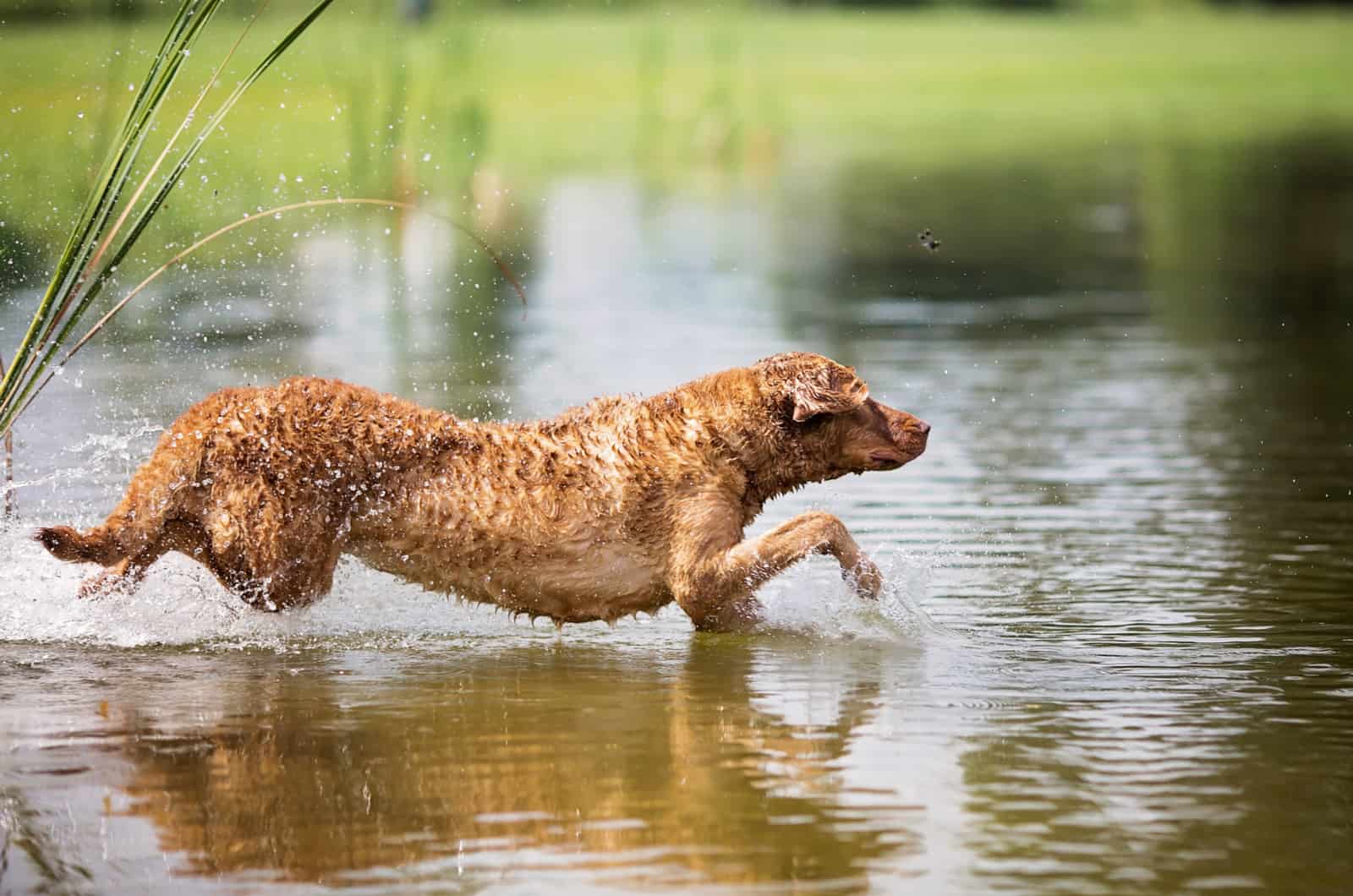
All in all, there aren’t many significant differences between male and female Chesapeake Bay Retrievers, apart from the few personality differences – both genders are equally versatile, obedient, intelligent, and eager to please their owners.
The differences between their personalities and energy levels will be most evident during puberty, when both genders go through a lot of hormonal changes.
As for which gender is better, that just depends on the personal preferences and needs of an individual owner – males are better suited for more active owners, while females are ideal for people who want a more laid-back companion.
Of course, Chesapeake Bay Retriever colors should be less of a priority than picking the appropriate gender to suit your lifestyle when you’re looking for a new puppy.
In Conclusion
Now that we’ve covered what Chesapeake Bay Retriever colors exist, you’re bound to have an easier time distinguishing between the different colors and shades that this breed comes in.
You can also brag to your friends about your extensive knowledge pertaining to Chesapeake Bay Retriever colors, and even throw in some professional slang words like Sedge and Deadgrass.
If you’re thinking about buying a Chessie puppy for yourself, just keep in mind that they can be a handful due to their high energy levels and prey drive – if you’re not an experienced dog owner but you still want a retriever dog, you might want to opt for a more manageable breed, like the Golden Retriever or Labrador Retriever.
If you still want to buy a new Chesapeake Bay Retriever puppy, make sure to source your new pup from a reliable and reputable breeder who knows what they’re doing.
Related articles:
• Labrador Colors: The Pinwheel Of Colors And Markings
